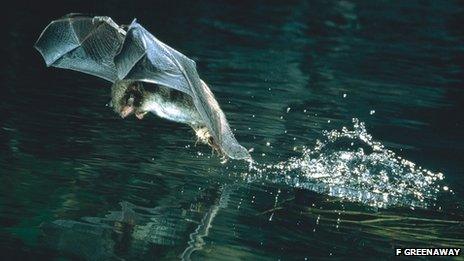Yorkshire bat colonies 'cohabit all year'
- Published

As a result of its hunting style, the Daubenton's bat has earned the nickname "sleepy hovercraft"
Colonies of Daubenton's bats in the Yorkshire Dales that have males and females living alongside each other all year round have surprised scientists.
Normally, the bats display "segregation behaviour", meaning the sexes live apart from the spring and only cohabit when they hibernate.
Researchers say it is the first documented example of temperate bats operating a "flexible social system".
Details of the study have been published in the journal Plos One.
Flappy families
Co-author John Altringham from the University of Leeds said the team discovered the unusual behaviour during a study of "swarming", which was when all the bats gathered at caves in the autumn and mated before hibernating.
"We, along with other people, had assumed that this was the primary mating event for this species and a lot of other related species," he said.
"So it was a surprise that at this one intermediary altitude there were males sharing roosts with females and getting an early opportunity to mate with them."
Prof Altringham said earlier study work showed that only males were captured at higher altitudes, at the top of the area's dales.
"It became clear that the females were basically staying lower down in the valleys because the weather was not good enough for them at the top of the valleys," he told BBC News.
"We measured the temperature and the insect abundance at... the top of the dale and it was too changeable and too inhospitable.
"If you are a female bat, you have got to produce milk and you have got a growing baby to produce, you just cannot feed enough high up the valleys.
"Males, on the other hand, can spend a lot of the summer in torpor. In the same way, they hibernate by going into torpor, they can do the same thing on a very short-term basis through the summer - if it is wet and windy and there is no food then they just shut down their body temperature and they just sleep it out.
"Females cannot do that because they have a foetus inside them, or they are producing milk."
'Flexible system'
The study by researchers from Leeds and Sheffield universities also collected genetic evidence that suggested males that shared roosts in the mid-altitude locations fathered the colonies' young, and were most likely motivated by the opportunity to mate earlier with females rather than waiting until bats congregated during the swarming season.
The BBC's Victoria Gill goes on a night-time bat hunt in Manchester's largest cemetery
"So, we have this two-stage mating system where there is this small group of privileged males, which we presume to be the healthier, more dominant bats - and they get the opportunity to share and mate with the females earlier, while all the rest have to go for the big mating event at the end of the summer," Prof Altringham explained.
With more than 1,200 bat species in the world, the researchers said the mammals displayed a diverse range of social and mating systems, but the most common system was segregation.
Prof Altringham explained: "What is unusual about this situation is that this system is not that common in temperate bats, and it has also not been documented before that these bats have the ability to change their social system - that change is driven by the environment, food resources and things like that.
"So, it is the flexibility that is new."
Commenting on the findings, director of science at the Bat Conservation Trust, Dr Karen Haysom, said: "This research gives us a fascinating insight into the complex social lives of bats and demonstrates how closely linked bats are to the environment."
- Published7 August 2012